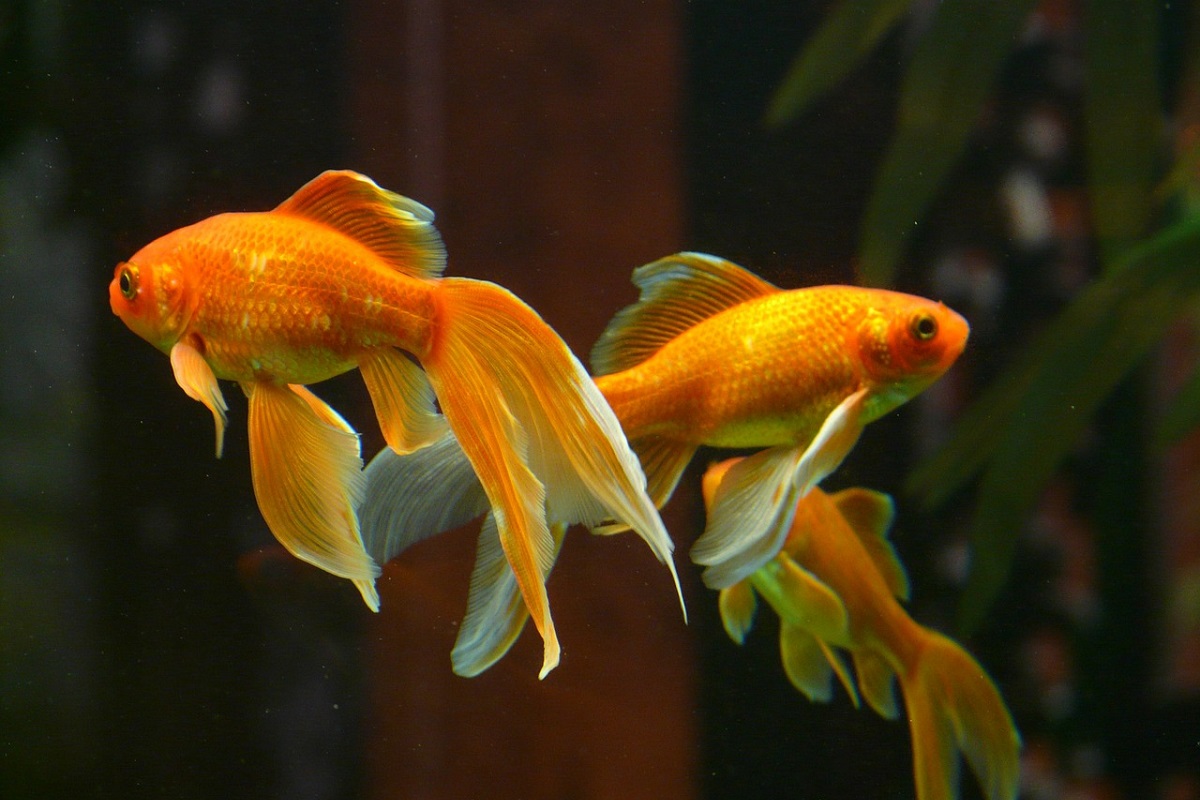Goldfish are the most popular aquarium fish and pet. They even have a cracker named after them!
Every pet shop practically sells this fish in plenty of colors, shapes, and sizes. Due to large-scale breeding, you can affordably get a fun and beautiful pet you can enjoy for many years to come.
Anyone who’s determined enough can take good care of goldfish. They’re easy to manage once you get the essentials up and running. One thing to take note of about them, though, is that their low temperatures make finding friends for them to live with to be quite difficult.
They’re pretty much quiet and make no fuss. Once you’ve got your tank settled, you just need to maintain its cleanliness regularly. This includes replacing half of the tank’s water once a month.
You won’t have a problem with their appetite as they can eat all day. This means goldfish produce a huge amount of waste on a daily basis, and their main illnesses are usually related to the digestive system. Sadly, even with the best goldfish diet, they can still suffer from gastrointestinal issues.
Now that you’ve got a gist of what the goldfish is all about, read on and find out more about this wonderful fish!
Contents
Origins of the Goldfish Pet
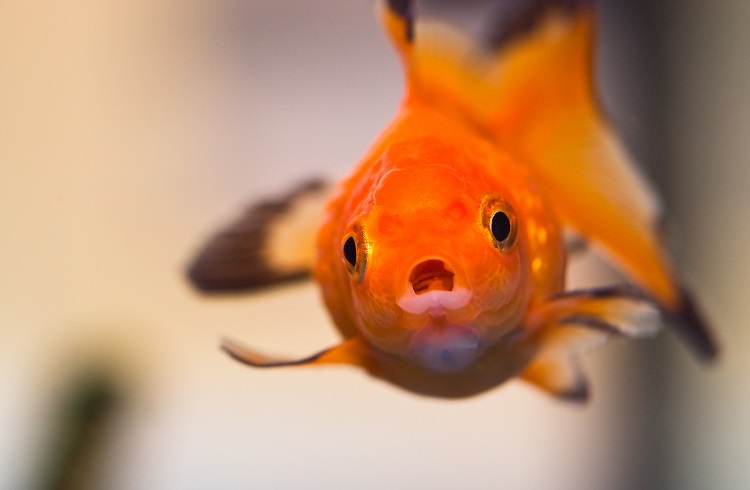
China was the first to see the goldfish’s potential of becoming a household pet. After domesticating the carp during the Tang Dynasty (6th Century A.D.), people began the process of artificial selection, breeding different carp species to bring out a golden hue.
Don’t mistake goldfish for its bigger cousin, the koi fish, which is also another type of carp. There’s also a misunderstanding that koi are just the bigger version of goldfish. They’re two different species!
By the 9th Century A.D., breeding goldfish for ornamental purposes became so widespread, only royalty could possess the yellow colored ones. The common folk, on the other hand, kept the ones that were orange.
Although they were mainly displayed outdoors in ponds, they were later brought inside the house, which gradually affected how they would survive in the years to come. After some time, they were brought to Japan in the early 1600s, and then to different European countries.
In Europe, the goldfish was a popular symbol of luck and fortune. Married men gave their wives a goldfish to celebrate their 1st anniversary, symbolizing flourishing years to come in their marriage. When goldfish became more common in the market, the tradition ended as something that used to be so rare could finally be bought by anyone.
By the mid-1800s, the goldfish was finally introduced to the United States, and the rest is history.
Natural Habitat for Goldfish

Goldfish normally dwell in a freshwater environment.
Similar to their carp ancestor, they flourish in a somewhat viscous body of water. In fact, they favor sluggish water regardless of temperature and surroundings.
Do Goldfish Have a Long Lifespan?
Despite the fact that a goldfish’s longevity can reach up to 15 years, improper care will force you to flush it down the toilet in less than three years – if it’s fortunate enough to survive that long, that is.
With an appropriate tank size that has the right conditions, proper diet, and timely feeding, your goldfish can potentially live its best life up to old age!
Does Goldfish Care Come Easy?
To say that a goldfish needs little upkeep is an understatement. Like buying any other pet, you can’t just make a decision on a whim especially if you’re a first time goldfish owner.
Having a clear and concise understanding of how to take care of a goldfish will definitely give you your money’s worth.
First and foremost, you need to consider where to house it, plus the accessories you will need along the way. It’s imperative that you keep it in a tank, however, as goldfish eventually outgrow bowls. Secondly, research about its diet and set up a feeding schedule. Lastly, plan what to do with its tank maintenance, which is crucial for its survival.
Goldfish Tank Setup

Choosing the best tank and setup for your pet goldfish will help determine its growth.
Whether you’re planning to add other fish, or just want to keep your pet goldfish happy, then you better prepare for some good tank maintenance. Let’s discuss furher on how to achieve this by looking at some important points below:
Why Goldfish Should Not Be Kept in Bowls
Although it’s stereotypical to house a pet goldfish in a bowl, it simply won’t survive for long.
Even a fancy goldfish type, which is relatively smaller, will find it quite stressful to swim around in such a cramped space. A distressing environment can affect your pet’s immune system, which will eventually develop it into a sick fish.
Goldfish Tank Size
It’s highly recommended that you buy your pet goldfish the biggest tank you can get. In fact, the amount of water in a bigger tank can help regulate the temperature.
A good rule of thumb for goldfish tank size is to get at least a 10 gallon tank for one goldfish and 20 gallons for two goldfish.
And who knows? You might be interested in other fish species in the near future. It’ll be a good opportunity to add new fish, or better yet, different goldfish varieties!
Lastly, a good tank size may be important, but oxygen absorption must be considered as well. Aside from the fact that goldfish require a lot of oxygen, they also poop a lot, creating a toxic environment if not tended to as soon as possible.
Goldfish Tank Temperature
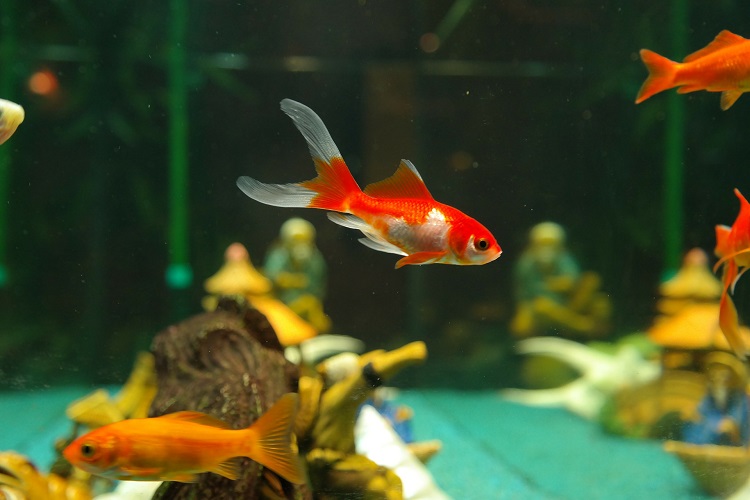
Although water quality in your goldfish tank should be on top of your priority list, the temperature is just as important when it comes to goldfish care.
The degree to which the water must dwell at must be pleasant enough for your goldfish. And for this, you will need a heater to help regulate and sustain a stable temperature.
So what exactly is the optimal temperature you should maintain in your goldfish tank? Well, a very good range should be between 68˚F and 74˚F.
This, however, resonates more with the fancy goldfish type, whose bodies can’t bear cooler temperatures in comparison to their common goldfish counterpart. They thrive best in water levels above 72˚F. Common goldfish, on the other hand, can still do well in waters with temperatures as low as 64˚F.
Water Quality and Filtration
You may have seen a couple of goldfish kept in bowls at your local pet stores that seemingly appear to be doing just fine.
Don’t be fooled, though. Aside from tiny to no swimming space, the poor water quality in these bowls will be detrimental to your new fish’s health. That’s why an essential part of having a goldfish aquarium or goldfish tank is the filtration system.
Your pet goldfish are insatiable eaters and will defecate profusely, inevitably creating a toxic environment in addition to all the excess food. In order to prevent this from happening, frequent water change must occur.
So how does a good filtration system aid in your goldfish care journey?
Basically, you will need the water to be constantly moving. A good filtration system prevents inactivity, which causes a surplus of food and nutrients to accumulate, and the possibility of your goldfish from ever getting poisoned.
Goldfish require a lot of oxygen to be able to breathe properly underwater, so good filtration is needed to aid in air circulation, taking air from the surface into the water.
Lastly, it helps clean contaminated water, which is one of the main causes of goldfish illness.
It’s highly recommended that you choose an external filter which hangs beside your goldfish tank. Although a bit on the pricier side, it works 10x better than the internal one, and won’t take up your tank space at all.
Goldfish Tank Decorations
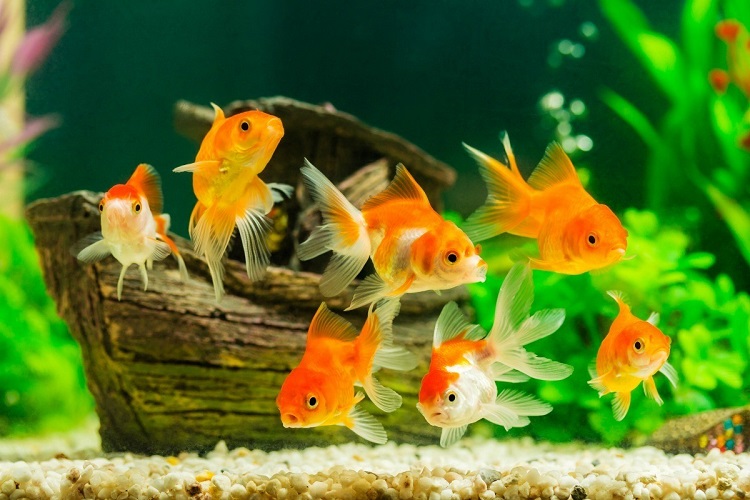
Now to a more exciting part of our goldfish car journey: goldfish tank decorations!
In the media, you often see aquarium fish circling about a tiny underwater castle. Of course, before heading to the pet store and buying something like that, you have to consider your goldfish tank size – make sure there’s enough swimming space for your goldfish. In addition, the material has to be non-toxic to avoid compromising the water quality.
So, what exactly is the first step?
First, you have to choose the substrate, which varies from fish to fish. Pea gravel, for instance, is hazardous to goldfish. Although goldfish can survive without substrate, having one can contribute to the surface area needed for good bacteria to thrive. This beneficial bacteria helps maintain nitrogen levels crucial to a goldfish’s overall well-being.
Next, we have plants. Are they necessary, though? And do you buy a fake one or a living one? Goldfish are known to ruin underwater plants because they tend to consume absolutely anything.
That’s why when buying live plants, it’s crucial to only get plants that are best suited to the environment of an aquarium goldfish. For instance, a strong plant will be able to cope with being ravaged by a goldfish.
On the other hand, some goldfish keepers decide to decorate using fake ones, since they do a decent job of making goldfish tanks look pleasant anyway. They also look a lot more vibrant and easier to maintain than the real ones.
However, the benefits of having live plants still outweigh the cons. They help in water quality improvement, absorbing CO2 emissions and breathing out oxygen into the tank, which helps balance oxygen levels.
Lastly, avoid going overboard when it comes to decor. Avoid using corals, wood, rocks, and plastics. These things usually contain elements that may add or disrupt the system in your goldfish tank.
In some cases, corals might even carry parasites that will infect your fish. Other objects can be toxic, as well, so pay attention to what you put inside.
What Do Goldfish Eat?
Take note that goldfish are omnivores and will basically eat all kinds of foods. The question is how do you balance their meals in order to achieve a healthy goldfish diet?
They should predominantly be fed with a mixture of specialized goldfish flakes and pellets, and preferably added with freeze-dried brine shrimp, and a couple of finely chopped vegetables. It’s also good to throw in a couple of tubifex worms as a treat.
To stick to a healthy diet, goldfish are normally supposed to eat twice or thrice per day to at least help regulate their nonstop eating habits. However, newbies who don’t know how to care for goldfish, they tend to overfeed these peaceful fish.
Make sure your goldfish is able to finish every portion you give it within 2 minutes. Anything over that is already in excess, and will just contribute to polluting their tank which will ultimately harm them.
Goldfish Behavior/Compatibility
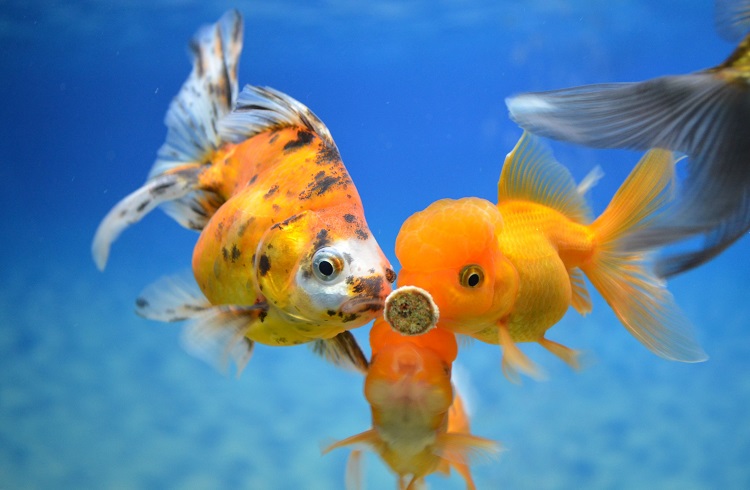
Goldfish keeping is quite easy since you’re dealing with a fairly peaceful fish. Believe it or not, they can actually tell apart their owner from other people. Do you feel special now?
Meanwhile, goldfish love hanging around others. So when adding fish to your tank, make sure they have a similar size and temperament. Other fish must also tolerate the temperature demands of a goldfish, however, which is on the cooler side.
Goldfish may be social, playful and intelligent, but it’s not that easy to look for their tank mates.
Check out our article to find the best tank mates and companions for your goldfish.
Do Goldfish Get Along With Others?
The most difficult step of creating a thriving company with these freshwater fish is deciding on the best goldfish mates. Goldfish are distinct in comparison to most tropical fish in the trade. As a result, there are several traits to consider for potential tank mates.
Also, you must consider the environment the other fish need to survive in. Don’t be tempted to place too many fish in the same tank. Congestion will cause increases in ammonia, a decline of oxygen in the water, and death in your fish.
In order to add new fish to your goldfish tank, they need to have a similar diet and temperature tolerance as your goldfish.
Goldfish that are securely kept on their own need plenty of swimming space. You cannot keep fancy goldfish with common goldfish, comets, and shubunkins. Meanwhile, other types of fancy goldfish like orandas, black moors, and fantails don’t get along with other fancy types such as ranchus.
Speed has mostly to do with this since faster fish are able to consume all the food right before the fancier ones are able to eat their portion. Fancier goldfish, on the other hand, are slower and also prone to nipping, which can also be the cause.
Additionally, as goldfish grow bigger, they will tend to consume smaller fish. However, reports say that this is highly unlikely if they grew up together with the smaller fish, which they won’t consider as prey, as they are used to their presence. However, it’s also not a guarantee whether or not they’ll eat their smaller companion.
Identifying and Treating Disease Problems

Goldfish may be tough, but they can also easily fall into illness if not properly cared for.
A sick goldfish may have come from less than ideal conditions. They must have also gotten infected when you added a new fish without isolating them first.
Sometimes, their illness can happen out of the blue a few days after bringing them home from the pet store. They probably were already carrying something from the start.
Having to face this kind of dilemma is part of goldfish keeping. It will often test you, but the experience is a great teacher, so it’s a win-win in the end.
Being able to detect the problem sooner will give you more chances to improve the condition of your fish. Noticing what’s wrong with your fish as soon as possible will help determine its prognosis. Take note that symptoms of water poisoning in goldfish are exactly similar to other diseases.
Generally, goldfish that are ill reside in an awful tank environment. That’s why it’s important to check the water at all times. It may appear clean at first glance, but it is actually so toxic, it will make your skin scrawl. This happens especially when you neglect to change the water often, and since goldfish are known to produce so much waste, it will eventually turn poisonous.
What’s causing the fish to get sick can only be two factors: ammonia and nitrite. Even just a tinge can have plenty of negative side effects.
Parasite, bacterial infections, and fungal diseases will ravage your poor goldfish if you continue to keep it in a disgusting environment. If you don’t act immediately and allow these to spread, they will consume your fish until they can no longer fight for their lives.
One good thing is that if you’re able to detect such illnesses early on, then your goldfish will still have the opportunity to thrive and be happy for many years to come.
Stay alert, though! Don’t ever put any sort of medication into the tank without fully understanding the root cause of the disease. Make sure you’ve done your research and asked the experts for help.

Ian Sterling, founder of Fishlab.com, began his aquarium journey over 30 years ago, driven by a deep fascination for fish and their diverse personalities. His website, Fishlab.com, is dedicated to making fishkeeping accessible and enjoyable, offering beginner-friendly guidance, expert insights, and a community for aquarists to connect and share experiences.


